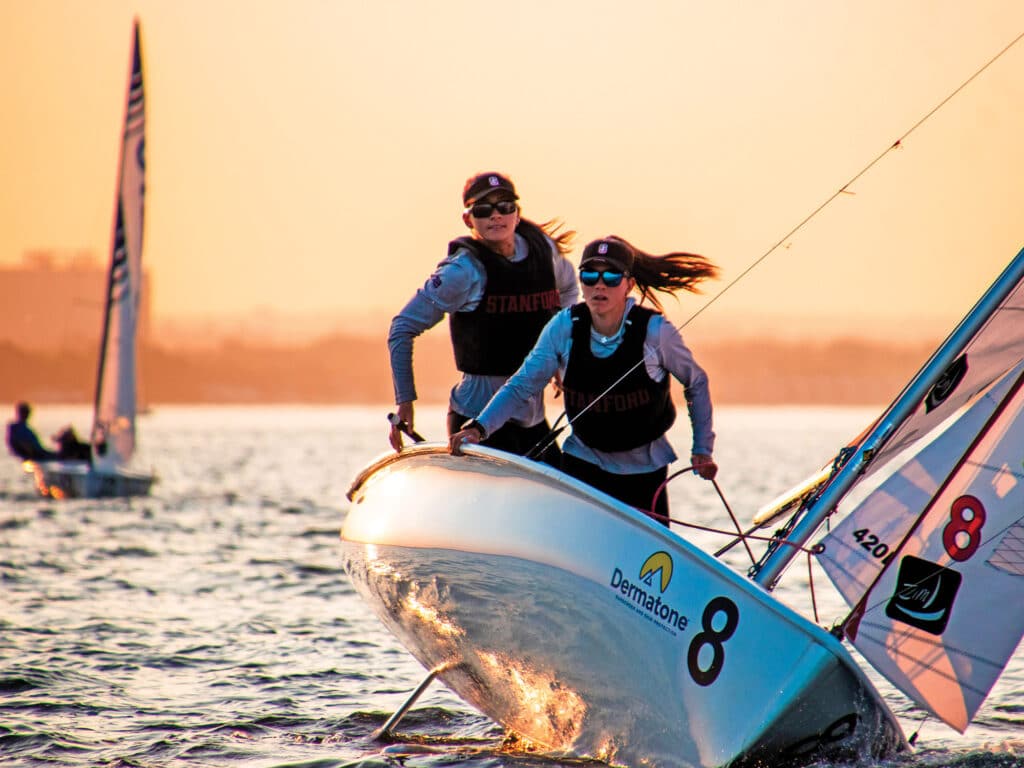
As the high-noon sun blazes the waters of the Long Island Sound, there’s no wind or even a ripple in sight. Dozens of college sailing teams shelter in tents erected on the US Merchant Marine Academy pier. It’s the fourth and final day of the 2023 ICSA Open Dinghy National Championship as racers, PROs and spectators alike wait patiently for the breeze to fill. With a 5 o’clock cutoff time, the postponement flag hangs limp. A palpable tension and anticipation are building. Something incredible is about to happen.
A gentle sea breeze finally emerges a few hours later, and the race committee scurries into action to run three races in each division. The winning sailors find a rhythm with the wind and the current, in tune with what is above and below them. As the sun sinks closer to the horizon, racing is called to a halt, and the news spreads from boat to boat: The women of Stanford Sailing have won the Open Dinghy National Championship.
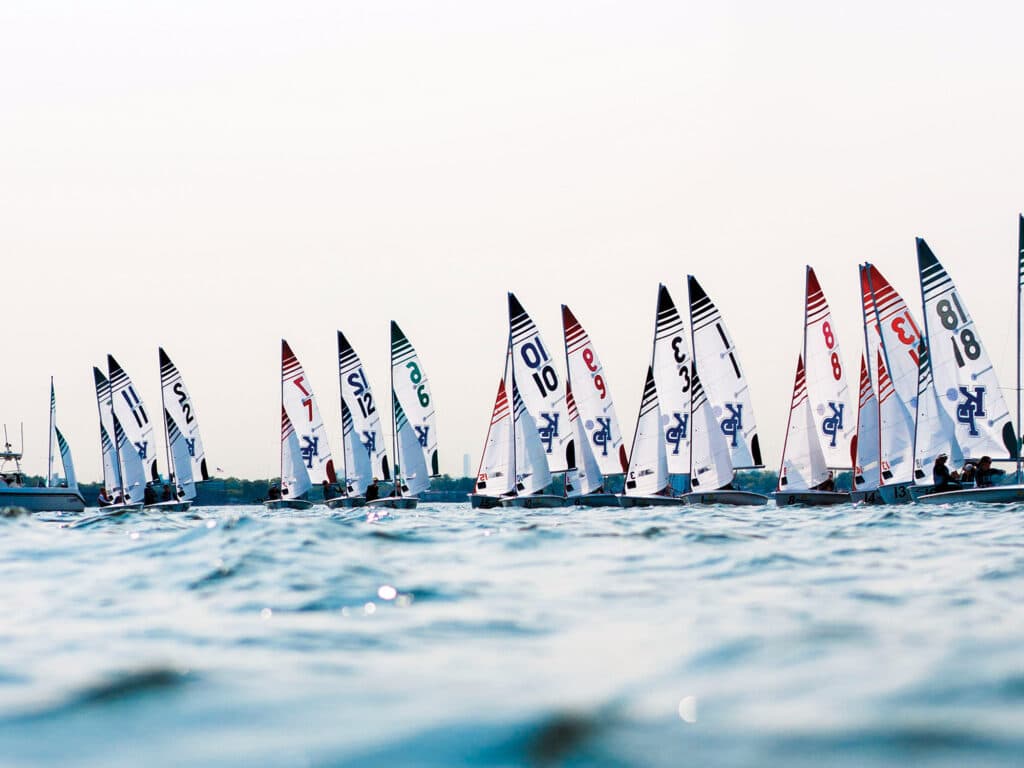
Hand in hand, the Stanford team leaps into the water as the monumental splash echoes the historical moment, for never before has an all-women squad won the most coveted college sailing title. The Open Dinghy National Championship featured female pairs as low-point winners in both the A and B divisions. Stanford senior Michelle Lahrkamp and junior Ellie Harned have earned the low-point score in the A division, while Yale’s Carmen Cowles and Anisha Arcot claimed the B division honors. The championship saw eight women skippers out of 44. In another historic first, Stanford fielded six women sailors for the Open Team Race Championship, and of the 25 skippers at the Open Team Race, four were women.
Conceived in 1937, the ICSA College Championship series began with the Henry A. Morss Memorial Trophy. First formed in the 1890s, ICSA racing was originally informal, featuring women and men sailors, until organized racing was introduced in 1928 with the George May Trophy. In 1961, after women were no longer permitted to race in varsity regattas, the New England Women’s Intercollegiate Sailing Association was formed, five years before the implementation of Title IX. Today, Title IX encourages universities to recognize women’s sailing as a varsity sport, whereas many open programs are considered a club.
As proof that their Open Championship win was no fluke, Stanford Sailing claimed both the Women’s Dinghy Championship and the Open Dinghy Championship for the first time in its program history, and finished second at both the Women’s Team Race Championship and Open Team Race Championship. Their undeniable skill and tenacity led the team to earn the Leonard M. Fowle Trophy for the first time in the university’s history.
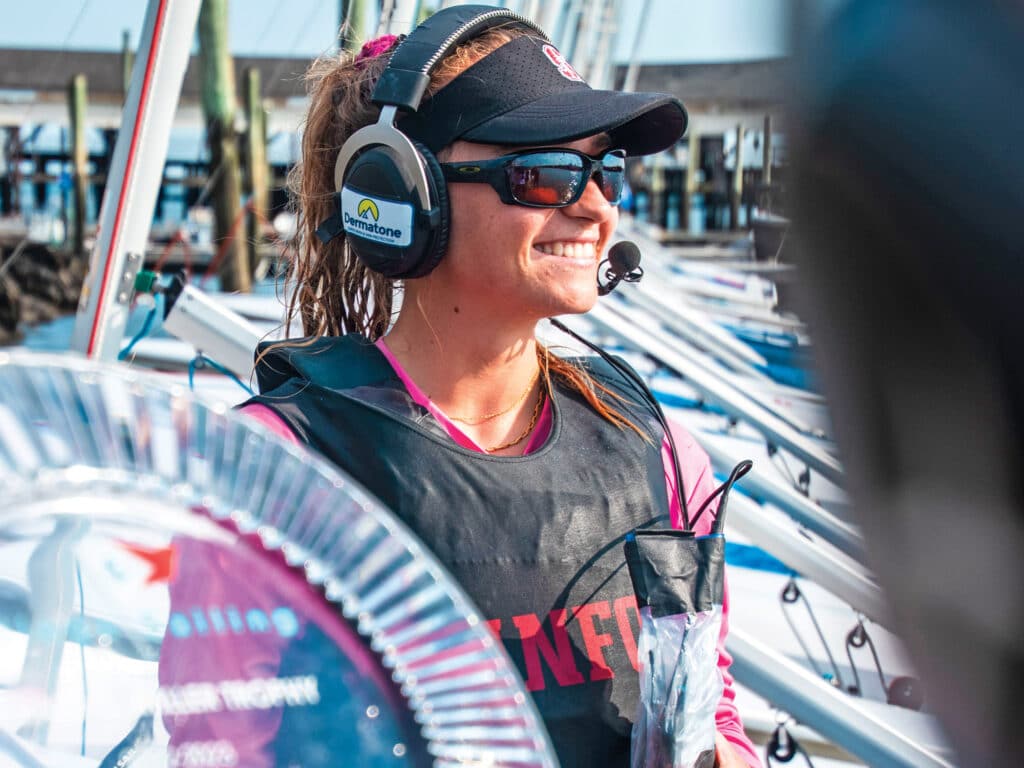
Stanford’s program is unique in that it sits on the opposite coast of the East Coast powerhouses, and it rosters only 18 members, an unusually small team in varsity collegiate sailing. The small team enables a strong coaching ratio of 6-to-1, or rather three doublehanded boats to one coach. Of the 16 racers, 13 are women. Perhaps, their secret lies in not only the size of their roster but also the chemistry among their sailors.
Trusting her training, Lahrkamp stepped into Nationals with one goal in mind: to win. After a disappointing performance at Kings Point at the 2022 Atlantic Coast Championship, the Stanford team came together to push themselves beyond what they previously thought possible. Their head coach, Chris Klevan, impresses the importance of dynamism within the team. “To foster all the qualities we want to cultivate, a coach must encourage the team to create its own momentum,” he says.
The team came together in almost unimaginable ways, Klevan adds. Captains Patricia Gerli and Hannah Freeman led the team, alongside seniors Lahrkamp, Justin Lim, AnaClare Sol and Abigail Tindall. Their practices were rigorous, repeating blender drill after blender drill; working intensely alongside their trainer, Tim Messina, to target specific muscle groups used for trimming and hiking; and studying tide and depth charts to determine exactly where and how the current would flow across the racecourse. Their dual practice venues—the light air Redwood Creek arena coupled with the chop and current of San Francisco Bay—enforced that the team be prepared for all conditions. Klevan credits the team’s success to improving every day they sailed and the mental toughness required to “not be beaten down by the fact that [they] had to sail a small group for 11 straight 12-hour days. [They] improved where others have faltered.”
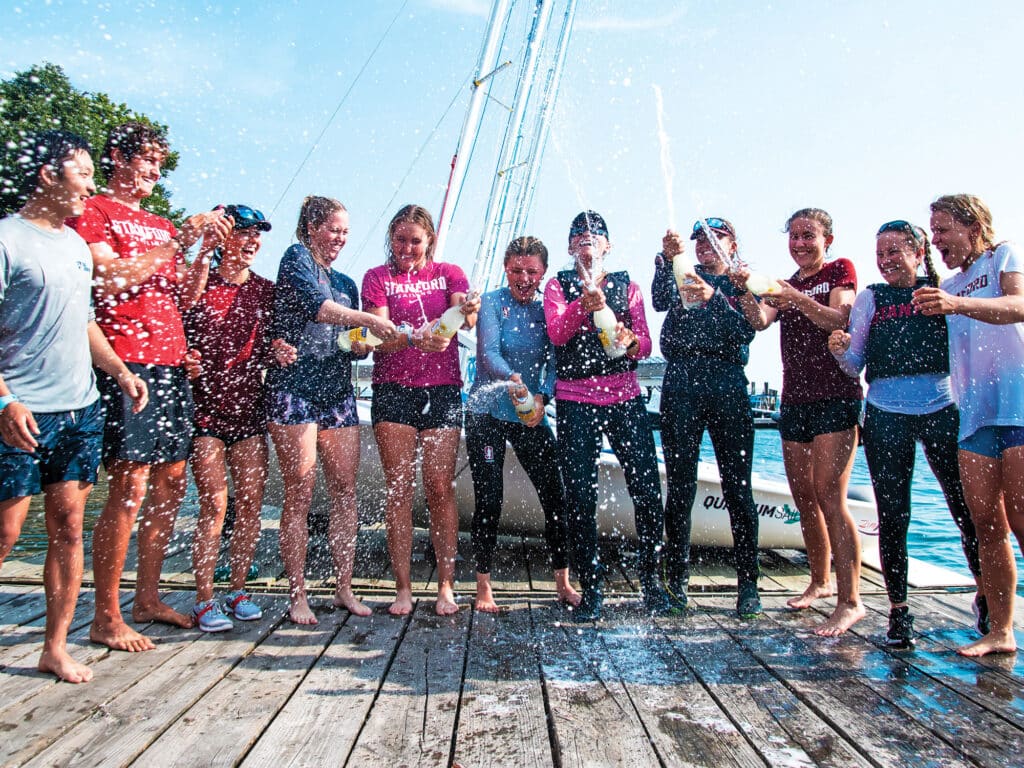
Lahrkamp had come close to tasting victory at past championships, winning the B division as the low-point score at the Women’s Dinghy Championships in 2021 and earning Stanford a program-best second-place finish overall. Lahrkamp has been making her own history as well. In 2020, she earned the Quantum Women’s Sailor of the Year Award, making her the first freshman to win such an award and the first Stanford athlete to take home the trophy. Klevan expresses that the team’s second-place finish at the Women’s Team Race Championship on their home waters back in April “taught our team that the score sheet captures so little of what actually goes into being a champion.”
In addition to their disciplined teamwork, Lahrkamp credits the team’s success to their meritocracy. “It’s a team-first mentality,” she says. “We’re all incredibly positive and supportive of one another while asking, ‘What does the team need right now?’” Lahrkamp also emphasizes that the Open Team was composed of “the best sailor[s], period. No matter their gender.”
The team’s strong coaching ratio created the opportunity for sailors to rise up and sail faster. Klevan’s cardinal transparency with the team enables the sailors to know exactly where they stand and the strengths they bring to the team. Freshman Vanessa Lahrkamp’s outstanding performance at the Women’s Dinghy Nationals, winning the B division by a 30-point margin, led her to skipper the B division for the Open Dinghy Championship, making it the first open regatta helmed by both sisters. With trust and equality woven into the team fabric, the Stanford team fleet was motivated to sail its best.
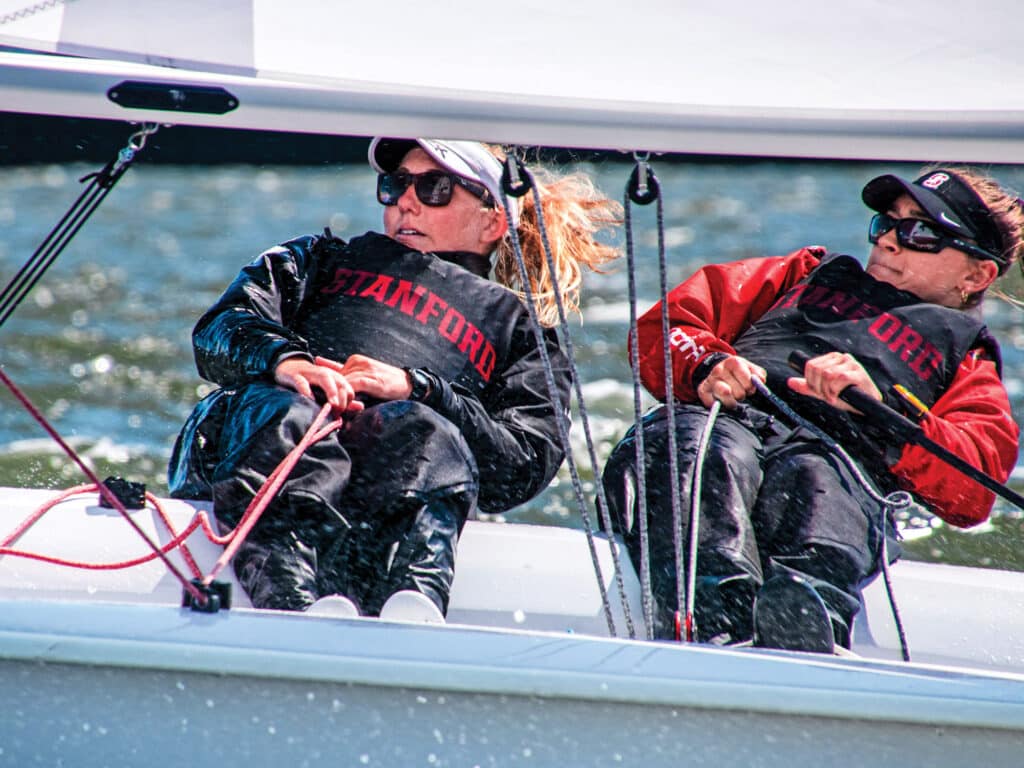
Lahrkamp takes comfort in knowing her coaches’ support for women skippers in the Open Division. Klevan previously trained top women sailors during his time with the US Coast Guard Academy, including Dana Rohde, who won the Quantum Women’s Sailor of the Year Award in 2019, and Nikki Barnes, who went on to the 2021 Tokyo Olympics in the 470. Klevan, however, stresses the importance of not making life easier for his athletes, but rather creating a hard day of work and “help[ing] them learn to enjoy what was once seen as challenging. You’ll be amazed how strong people can be when you allow them to realize their own preconceived limitations are far from their potential,” he says.
With the recent implementation of The Inclusivity, Diversity and Equity Task Force (TIDE), of which Lahrkamp is a member, as well as the Sexual Violence and Sexual Assault Task Force, college sailing is building a more fair and open community. The addition of the Women’s Team Race Championship provides three national championships restricted to women only, on top of the Match Race Championship that demands mixed-gender or all-women teams. The ICSA women’s circuit uplifted women drivers, so they now compete in open regattas on a more regular basis. As for Lahrkamp, she hopes to compete in all-women squadrons, with the goal of yacht-club and brand sponsorships.
Upon returning to Palo Alto, peers and community members welcomed Stanford Sailing home with universal celebrations, with other athletic ventures seeing sailing as an equalizer sport for the first time. If anything, the Open Championship win confirmed that extraordinary potential lives within every sailor and individual. Provided the right tools and support, along with their own determination, history was indeed made on the Long Island Sound. It was a great day for sailing, and an even better day for college sailing.









